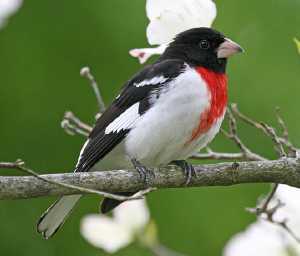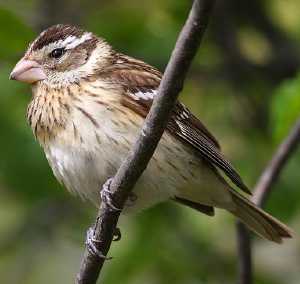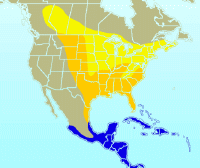  Rose-Breasted Grosbeak Rose-Breasted GrosbeakPheucticus ludovicianus
Description
This stocky, medium-sized
songbird is 7-8.5 inches long, has a wingspan of
11-13 inches, and weighs 1.4-1.7 ounces. It is broad-chested,
with a short neck and a medium-length, squared
tail.
Adult males are black above and white below,
with a brilliant red chevron extending from the
black throat down the middle of the breast, white
patches on the upper sides of the wings and red
markings on the undersides that are clearly
visible in flight. The red breast becomes duller
when the male is not in its breeding plumage.
Adult females are brown above,
with white wing patches, streaked brown breast,
and pale eyebrow. Both sexes have a heavy,
short, pinkish bill, dark brown eyes, and
grey-blue to black legs. Juveniles look like
adult females, but the wings and tail are usually
browner, the breast is buff, and it is less
heavily streaked overall.
 Distribution and Habitat Distribution and Habitat
The rose-breasted grosbeak breeds from western
Canada south through the United States east of
the Continental Divide, and winters from central
Mexico south through Central America into
northern South America, as well as many Caribbean
islands.
Throughout its range, this bird is found in
both deciduous trees and conifers. It is most
common in regenerating woodlands and often
concentrates along forest edges and in parks.
During migration, rose-breasted grosbeaks
frequent fruiting trees to help fuel their
flights. It usually begins its northward
migration between mid-March and mid-April, and
starts south in mid-September, with most flight
taking place at night.
Reproduction
At the beginning of the breeding season, the
female rose-breasted grosbeak approaches a
singing male, who in turn performs a courtship
display involving flight, positioning and song.
Once formed the pair is monogamous.
Nest-building usually takes place between May
and June, with both sexes taking part in the
process. The site is usually in a vertical fork
or crotch of a sapling 5-50 feet above the
ground, usually in forest openings, overgrown
field edges, old pastures, shrubby roads,
railroad rights-of-way, gardens, parks, or
residential areas. The nest itself
is a flimsy saucer of twigs, stems, and grass
that measures 3.5-9 inches across and 1.5-5
inches high on the outside (3-6 inches across and
1-3.5 inches deep on the inside). Red-breasted
grosbeak nests are often so flimsy that the eggs
can be seen through the bottom.
Three to five pale blue or
green eggs spotted with brown splotches (each
about 1 inch long) are laid between mid-May and
July and incubated by both parents for 9-13 days.
The young are fed insect matter by both
adults and may fledge the nest just 9 days after
hatching, although fledging at around 10 days is
more common. The young are dependent on the
adults for around 3 weeks after fledging, with
family groups being maintained until migration
occurs at the end of the summer.
Diet
During the breeding season rose-breasted
grosbeaks eat a lot of insects, as well as wild
fruit and seeds. They mostly feed on berries
during fall migration, and on their wintering
grounds they have a varied diet of invertebrates
and plant material. They are also frequent
visitors to backyard bird feeders, where they eat
sunflower seeds with abandon.
Other Information
Males sing to establish territories and
attract females, as well as during nest-building
and incubation. Their distinctive call note is a
sharp, penetrating, metallic eek-eek that is
similar to that of an American robin, but softer
and more melodious.
During the breeding season, the male and
female rose-breasted grosbeak are intolerant of
other individuals and are often involved in
conflicts when defending their territory. During
winter and migration, however, this species is
relatively gregarious, forming flocks of up to 50
birds
Scientific
Classification
phylum Chordata
subphylum Vertebrata
class Aves
order Passeriformes
family Emberizidae
genus & species Pheucticus ludovicianus

Arkive http://www.arkive.org/rose-breasted-grosbeak/pheucticus-ludovicianus/
Cornell Lab of Ornithology http://www.allaboutbirds.org/guide/rose-breasted_grosbeak/id
National Audubon Society http://birds.audubon.org/birds/rose-breasted-grosbeak
Questions or comments about
this page?
|



